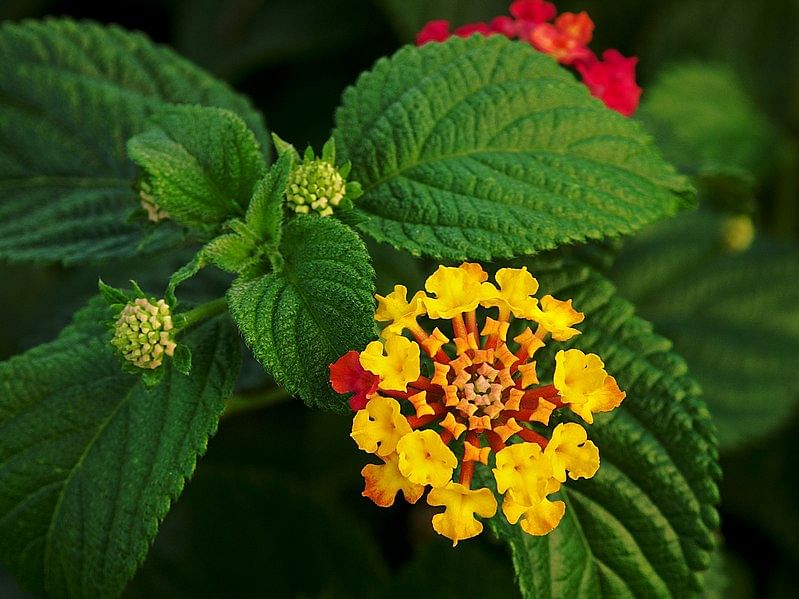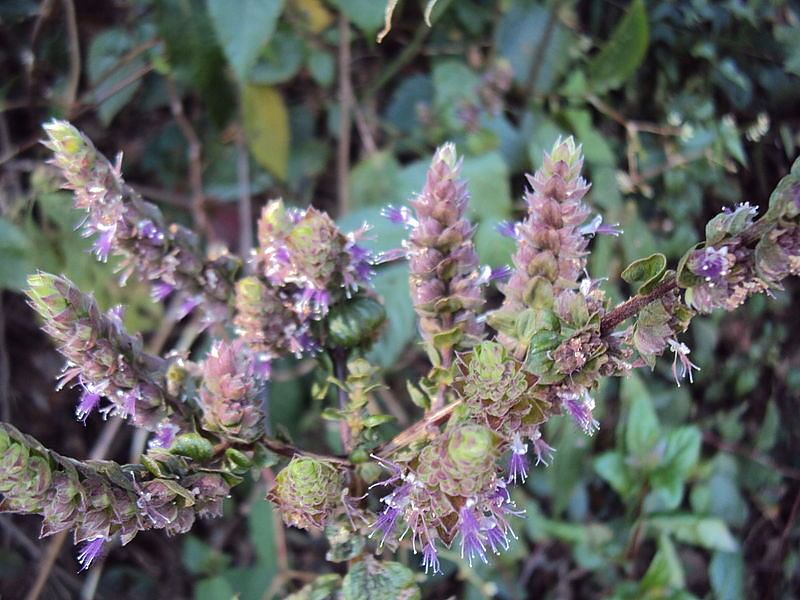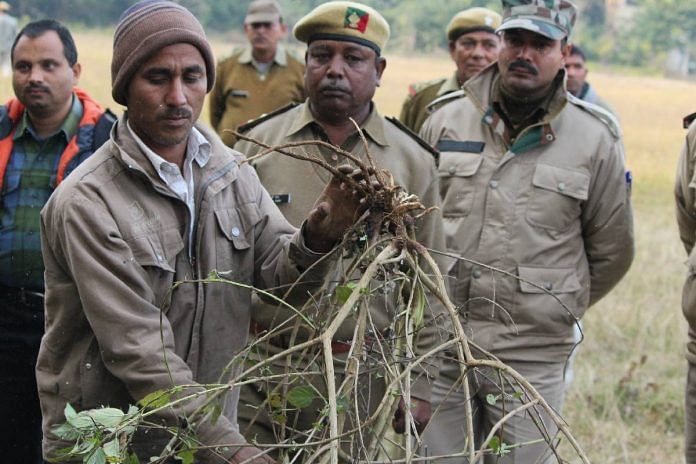New Delhi: A silent threat to India’s biodiversity lurks in plain sight. New research suggests the havoc it can wreak is worse than previously thought, and if unchecked, could imperil India’s top predators, including the tiger.
In the garb of a lush green appearance, invasive alien plant species like Lantana camara, a commonly found decorative plant, have colonised national parks across the country, a 2020 study found. Its spread has resulted in changes in ecosystem function, and the shrinking of native species indigenous to a particular region.

New research from Madhya Pradesh has found evidence of what could become an “invasional meltdown” — when one invasive species works with a second to magnify negative impacts, with repercussions across the food chain.
Researchers from the Wildlife Institute of India (WII) found that the co-occurrence of lantana and Pogostemon benghalensis (Bengal shrub-mint, another non-native plant) caused a “significant decline in the richness of native plants and that of palatable plants” in Madhya Pradesh’s Kanha Tiger Reserve.
They documented their findings in a study published in January. “The scale and implications of the problem are devastating,” Y.V. Jhala, senior conservationist and co-author of the paper, told ThePrint.
Multiple invasions of this kind can “cause a future decline of herbivores” in Kanha, the study warns, adding that if the problem persists, it can “directly influence the sustenance of large mammals in the landscape”, potentially affecting predators like leopards and tigers.
“In many areas, the herbivores hardly had anything to eat,” Rajat Rastogi, lead author of the paper, told ThePrint. Co-authored by WII scientists Qamar Qureshi and Jhala, it is the first study to shed light on the effects of multiple invasions within an ecosystem in India.
The findings from Kanha point to India’s vulnerability to invasive alien species in the backdrop of weak counter measures. India is the second-most invasive cost-bearing country in the world, after the US. Invasive alien species have cost India’s economy Rs 8.3 trillion over the last 60 years, Mongabay had reported last month.
According to a 2010 study, the effects of climate change, changes in land use, and development will only deepen this vulnerability.
Also Read: 40 tigers have died since start of year, shows govt data. Age, fights, electrocution major causes
Erosion in Kanha
India is among the few mega biodiverse countries in the world, according to the United Nations Convention on Biological Diversity, hosting between 7 to 8 per cent of the world’s biodiversity despite occupying a miniscule 2 per cent of the Earth’s total land mass.
But invasive alien species — those introduced to places outside their natural habitat at the peril of native species — are slowly eroding this richness.
The WII study found that, while on an average two individual species were lost with every 10 per cent rise in a single invasion, a similar rise in invasions by Lantana and Pogostemon together nearly doubled the losses.
Sal trees are abundant in certain parts of Kanha, but where there were co-occurring invasions, the trees struggled to regenerate to a more acute degree, according to the study.
“Grass and herbaceous vegetation cover declined with an increase in independent as well as additive invasions, where the effect of additive invasion was relatively stronger,” it added.
The invasive plants outcompete native species by altering the nutrients from the soil which, can arrest their growth. The result is less nutritious plants for herbivores where levels of invasion are high.
“This might slowly deplete the native ungulate (hoofed mammal) population due to resource exhaustion and might lead to diseases in the herbivores,” the WII paper said. Herbivores can tolerate Lantana in their diet to a certain extent, but the stems in particular are a source of toxicity beyond a limit.
S.K. Singh, field director (Project Tiger) at Kanha Tiger Reserve, told ThePrint that the physical fitness of herbivores tended to be better in areas where ample palatable grasses were available, compared to where they were not. He also acknowledged that both invasive plant species — Lantana and Benghalensis — were pervasive, but tended to be more so in the wooded part of the forest compared to the grasslands.
“Grasses are not being made available to herbivores. In the absence of grasses, they’re going for the tender leaves of these invasives,” Singh said. “But invasive species are not the only reason for limited grasslands. We need to study all the factors contributing to poor physical fitness,” he added.
A senior official with the National Tiger Conservation Authority (NTCA), who did not wish to be named, said that while detailed “analysis and interpretation” were lacking in the study, its findings were robust, and should be scaled up in other parts of the country.
“Similar studies can be replicated in tiger reserves of the country where invasion is a pressing issue,” the official said, adding, “Technical assistance can be sought from WII. Based on such a database, NTCA can also come up with standard operating guidelines for management of invasives subsequently.”
Lack of regulatory framework
The paper’s findings come at a time when India has adopted a controversial definition of invasive alien species and has no roadmap of how to fix the problem, despite years of dealing with it.
India’s battle with managing Lantana — considered one of the top 10 most noxious invasive alien species — for example, began over 200 years ago when the plant was first introduced as an ornament originating from South America. Since the 1800s, lantana’s reach across India has steadily grown. A 2020 study by the WII found that it’s spread across 44 per cent — or 1.5 lakh square kilometres — of the country’s tiger reserves.
The study set off alarm bells for policymakers. According to a 2021 office memorandum, accessed by ThePrint, the Union Ministry of Environment, Forests and Climate Change constituted a committee chaired by the Indian Council of Forestry Research and Education (ICFRE), whose mandate was to come up with a draft policy for invasive species management.
However, neither a draft nor a final policy has materialised in the public domain since the committee was first constituted.
Rastogi said he hopes the findings from Kanha attract the political will needed to improve the science around invasive species management, which at the moment is driven by ad-hoc measures.
Funds for Lantana management are routinely drawn from the Compensatory Afforestation Fund Management and Planning Authority (CAMPA), Project Tiger, and state forest departments. However, the costs are exorbitant — it costs Rs 14 lakh to control one square km of Lantana, according to the 2020 WII study.
Typically, Lantana is uprooted or cut and burned to get rid of the thicket. Research by the Ashoka Trust for Research in Ecology and the Environment says, however, that “no Lantana removal is likely to be effective without post-removal monitoring and weeding” — a practice whose adoption isn’t well known.
According to Project Tiger field director S.K. Singh, even the Rs 2 to 3 crore that Kanha gets every year to manage invasive plants isn’t enough because of the sheer volume of invasive plants, which are quick to re-establish.
In Karnataka’s Bandipur tiger reserve, where Lantana invasion is severe, the reserve administration is experimenting with a technique under a new state initiative for grassland management.
“Each range has a target of removing 10 hectares of Lantana per year. We do it phase-wise, because we don’t always get manpower. Then we maintain the grasslands by preventing regrowth in those areas, so the native grasses can come up,” said Manjunath, Hediyala range officer in Bandipur Tiger Reserve. The reserve is spread across 912 sq km (91,200 hectares) with 3 subdivisions and 13 ranges.
However, the governance issues involved with managing invasive alien species go beyond just a lack of national policy.
The Wildlife Protection Act, amended in December 2022, defines invasive alien species as those that are “not native to India” and whose “introduction or spread may threaten or adversely impact wildlife or its habitat”.
The amended Act, which comes into effect on 1 April, gives the central government powers to “regulate or prohibit the import, trade, possession or proliferation of invasive alien species which pose a threat to the wildlife or habitat in India.”
India’s national definition also departs from the widely accepted one set by the UN-CBD, which defines invasive alien species as those that have been introduced to an environment outside their natural habitat, which negatively impact native biodiversity.
Defining invasive species by political boundaries, as opposed to ecological regions, is harmful, conservationists have said.
“It’s too narrow a definition of what can be considered an invasive species. Species exist according to their biogeographic affinities, not along political boundaries,” explained WII study co-author Rastogi.
Pogostemon, for example, is not listed as an invasive species by the National Biodiversity Authority because it is native to parts of West Bengal, but it acts like an invasive weed in central India, where it isn’t typically found.

Managing invasive alien species
The Kunming-Montreal Global Biodiversity Framework, an international agreement under the UN-CBD signed last year, compels member states — including India — to “eliminate, minimise, reduce and or mitigate the impacts of invasive alien species on biodiversity and ecosystem services,” by 50 per cent by 2030.
According to Milind Bunyan, fellow and assistant professor at the Ashoka Trust for Research in Ecology and the Environment (ATREE), the science of invasive species management is still evolving, and there’s reason to be optimistic.
“We can’t wait for the perfect science, and every attempt to manage invasive plants gives us greater insight into how to move forward. There is no one size fits all method to deal with the problem, and solutions have to be specific to a region’s ecology. The good news is that there is growing recognition of this.”
But as climate change sets in, the spread of some invasive species is likely to accelerate, the International Union for Conservation of Nature — an international, non-government organisation working in the field of nature conservation — has said.
In nearby Jharkhand, researchers have found that the spread of Lantana will accelerate as temperatures rise, facilitated by climate change. The evidence points to the urgent need for better management strategies.
“My proposition is that areas that are devoid of invasive weeds should be managed in a manner where they are not coming in. Current management strategies haven’t been tested scientifically, and there’s a huge cost involved,” said Jhala.
Ninad Mungi, a postdoctoral researcher at Aarhus University in Denmark and an author of the Intergovernmental Science-Policy Platform on Biodiversity and Ecosystem Services (IPBES) assessment on invasive species, is of a similar view. He was lead author of the 2020 WII study on Lantana prevalence in tiger reserves, and during his PhD research, found that 11 invasive plant species were present in over 60 per cent of India’s natural areas.
IPBES is an intergovernmental organisation considered the most authoritative voice on biodiversity research, and is often likened to the IPCC. It conducts assessment reports of existing knowledge, provides policy support, and engages in capacity building.
“The solution becomes a lot more complex when you see just how prevalent these species are. They cannot all be removed or phased out,” Mungi said.
Trade, habitat fragmentation, deforestation, and implementing linear projects like road building are some of the biggest drivers of invasive alien species in India. Strategies should focus, he argued, on protecting areas from human interference as far as possible, and making ecosystems resilient to invasion.
Habitat fragmentation is when a large contiguous habitat is divided smaller, leaving smaller unconnected areas — road construction, urbanisation are some activities that fragment natural spaces.
“One way to prevent the spread from occurring in areas that are devoid of invasives is to limit habitat fragmentation, canopy forest fires, and groundwater depletion,” Mungi said. Virgin forests, with plenty of resource competition among native fauna, are least likely to be invaded for these reasons, he said.
“In moderately productive forests, like Corbett and Kaziranga, invasives can also be managed by controlling the populations of megaherbivores, like elephants and rhinos, who feed on invasive plants as part of their diet. But the relentless uprooting isn’t a viable solution.”
Emerging research suggests the way forward is to integrate management with nature-based solutions that involve minimal human intervention.
“Up to a certain threshold, the effect of invasions may not show an outward impact. But once that threshold is crossed, the impacts will be cascading. It’s important to restore these ecosystems before that happens,” said Mungi.






